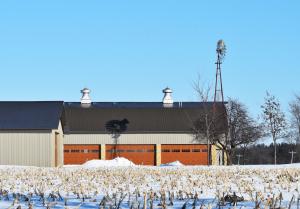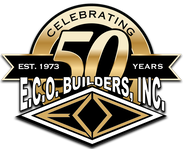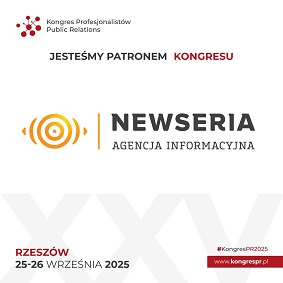Barndominium Framing: Key Differences Between Metal and Wood Structures, Says Louisiana Contractor
Elwin Ordoyne, Vice President of E.C.O. Builders Inc. in Slidell, Louisiana, emphasizes that material selection depends on multiple factors, including climate conditions, local building codes, desired finish options, and overall project goals.
“Metal and wood each serve different purposes and perform differently under various stress conditions. The best choice depends on what the project requires structurally and operationally,” said Ordoyne.
Metal Framing
Metal framing—often made from steel—is commonly used in barndominium construction due to its strength and resistance to pests and moisture. Pre-engineered metal buildings are frequently chosen for their ability to support large, open spaces without the need for interior load-bearing walls. This makes them suitable for combined living and work areas, storage, or open-concept layouts.
Steel framing components are precision-manufactured, which allows for consistent sizing and reduced waste. These frames can also be fabricated off-site and assembled quickly on location, helping to control construction schedules. Galvanized coatings protect steel framing from corrosion, especially in humid or flood-prone regions.
One consideration with metal framing is insulation. Steel is a conductive material, and without a thermal break, it can transfer heat or cold into the interior. Proper insulation systems—such as spray foam or rigid board insulation—are required to regulate indoor temperature and prevent condensation buildup inside walls and ceilings.
Metal-framed barndominiums also require specific tools and knowledge during construction. Connections are often made with bolts or self-tapping screws, and framing components may need to be cut with specialized equipment. Labor familiarity with steel framing influences efficiency and precision during installation.
Wood Framing
Traditional wood framing, often referred to as “stick framing,” remains a common choice for barndominiums in residential zones. Wood is widely available, easily modified on-site, and familiar to most framing crews. It supports a broad range of architectural styles and interior finishes, making it a flexible option for custom designs.
Wood framing provides natural insulation and is less conductive than metal, making thermal transfer less of a concern. In many cases, standard batt insulation fits directly into wood-framed walls, reducing the need for additional thermal solutions. Wood also absorbs and releases moisture gradually, helping to moderate indoor humidity levels.
Framing with wood may offer greater compatibility with traditional roofing systems, siding products, and trim packages. For property owners seeking a conventional residential appearance or finish, wood framing often aligns better with those preferences.
However, wood is more susceptible to termite damage, rot, and warping in high-moisture areas. Treatments such as pressure-treating or using rot-resistant lumber can reduce these risks, but ongoing inspection and maintenance remain important.
Code and Zoning Considerations
Local building codes and zoning requirements may affect framing decisions. In some jurisdictions, specific fire ratings or structural wind loads must be met, particularly in hurricane-prone areas like coastal Louisiana. Metal buildings may offer advantages in these conditions due to engineered strength and uniform load distribution. Wood structures may require additional bracing, sheathing, or anchors to comply with wind and impact requirements.
Permitting processes may also differ. Some municipalities require separate approval processes for metal-framed structures, including wind uplift calculations, stamped engineered drawings, and additional inspections. Understanding the permitting timeline and documentation requirements helps prevent project delays.
Cost Factors
Cost comparisons between wood and metal framing vary depending on current material prices, labor availability, and building size. Metal often has a higher upfront material cost but may reduce long-term maintenance expenses. Wood may have lower material and labor costs initially but may require more repairs over time, especially in regions with high humidity or termite activity.
Material fluctuations in both markets affect budget planning. Steel prices may rise with changes in demand or supply chain disruptions, while lumber prices can vary based on seasonal availability and natural disasters. Evaluating both short-term construction costs and long-term operational costs helps determine overall value.
Design Flexibility
Metal framing allows for wide-span roof systems and column-free interiors, ideal for workshop spaces, vehicle storage, or recreational areas within a barndominium. Wood framing offers more flexibility with interior wall placement and architectural detailing. Hybrid models that combine both wood and metal elements are increasingly used to balance design goals with structural requirements.
Long-Term Performance
Durability and maintenance also differ between materials. Metal is resistant to mold, termites, and fire, but may require coatings or treatments to prevent corrosion in coastal or high-humidity areas. Wood offers proven performance in residential construction but may be compromised if not properly sealed and ventilated.
Weather resistance, pest control, insulation needs, and environmental exposure all factor into long-term performance. Regular inspection schedules help preserve structural integrity, regardless of material.
Selecting between wood and metal framing for a barndominium involves more than material preference. Understanding how each material functions within the local environment, the intended use of the structure, and long-term maintenance goals is essential for a successful build.
Morgan Thomas
Rhino Digital, LLC
+1 504-875-5036
email us here
Visit us on social media:
Facebook
Legal Disclaimer:
EIN Presswire provides this news content "as is" without warranty of any kind. We do not accept any responsibility or liability for the accuracy, content, images, videos, licenses, completeness, legality, or reliability of the information contained in this article. If you have any complaints or copyright issues related to this article, kindly contact the author above.
Drilling Waste Management Market to Hit $8.2 Billion by 2033 | Sustainable Oil & Gas Solutions
Markifact Launches: AI Marketing Automation Platform Disrupting Reporting, Campaign Analysis, and Creative Generation
Garena, NetEase Games, and Ourpalm to Enter Retail Space Through UniPin’s Strategic Partnership with Jollibee
Kalendarium
Więcej ważnych informacji
 Jedynka Newserii
Jedynka Newserii

 Jedynka Newserii
Jedynka Newserii

Prawo

KE proponuje nowy Fundusz Konkurencyjności. Ma pobudzić inwestycje w strategiczne dla Europy technologie
W środę 16 lipca Komisja Europejska przedstawiła projekt budżetu na lata 2028–2034. Jedna z propozycji zakłada utworzenie Europejskiego Funduszu Konkurencyjności o wartości ponad 400 mld euro, który ma pobudzić inwestycje w technologie strategiczne dla jednolitego rynku. Wśród wspieranych obszarów znalazła się obronność i przestrzeń kosmiczna. Na ten cel ma trafić ponad 130 mld euro, pięciokrotnie więcej niż do tej pory.
Firma
Były prezes PGE: OZE potrzebuje wsparcia magazynów energii. To temat traktowany po macoszemu

Choć udział odnawialnych źródeł energii w miksie energetycznym Polski jest stosunkowo wysoki i rośnie, to ten przyrost jest chaotyczny i nierównomiernie rozłożony miedzy technologiami – wskazuje Forum Energii. Dodatkowo OZE potrzebują wsparcia magazynów energii, a zdaniem Wojciecha Dąbrowskiego, prezesa Fundacji SET, ten temat jest traktowany po macoszemu. Brak magazynów powoduje, że produkcja energii z OZE jest tymczasowo wyłączana, co oznacza marnowanie potencjału tych źródeł.
Infrastruktura
Wzrost wynagrodzeń ekip budowlanych najmocniej wpływa na koszty budowy domu. Zainteresowanie inwestorów mimo to nieznacznie wzrasta

Budowa metra kwadratowego domu w Polsce kosztuje od 5,55 do 6 tys. zł w zależności od województwa – wynika z najnowszych analiz firmy Sekocenbud. Najdrożej jest w Warszawie, gdzie cena za metr kwadratowy domu przekroczyła już 6,2 tys. zł. Na przyrosty kosztów budowy domu wpływają zarówno drożejące materiały budowlane, jak i wyższe wynagrodzenia pracowników. Inwestorzy nie rezygnują jednak z budowy domów jednorodzinnych, co ma związek m.in. z wciąż wysokimi cenami mieszkań czy też obniżką stóp procentowych.
Partner serwisu
Szkolenia

Akademia Newserii
Akademia Newserii to projekt, w ramach którego najlepsi polscy dziennikarze biznesowi, giełdowi oraz lifestylowi, a także szkoleniowcy z wieloletnim doświadczeniem dzielą się swoją wiedzą nt. pracy z mediami.










.gif)

 |
| |
| |
|